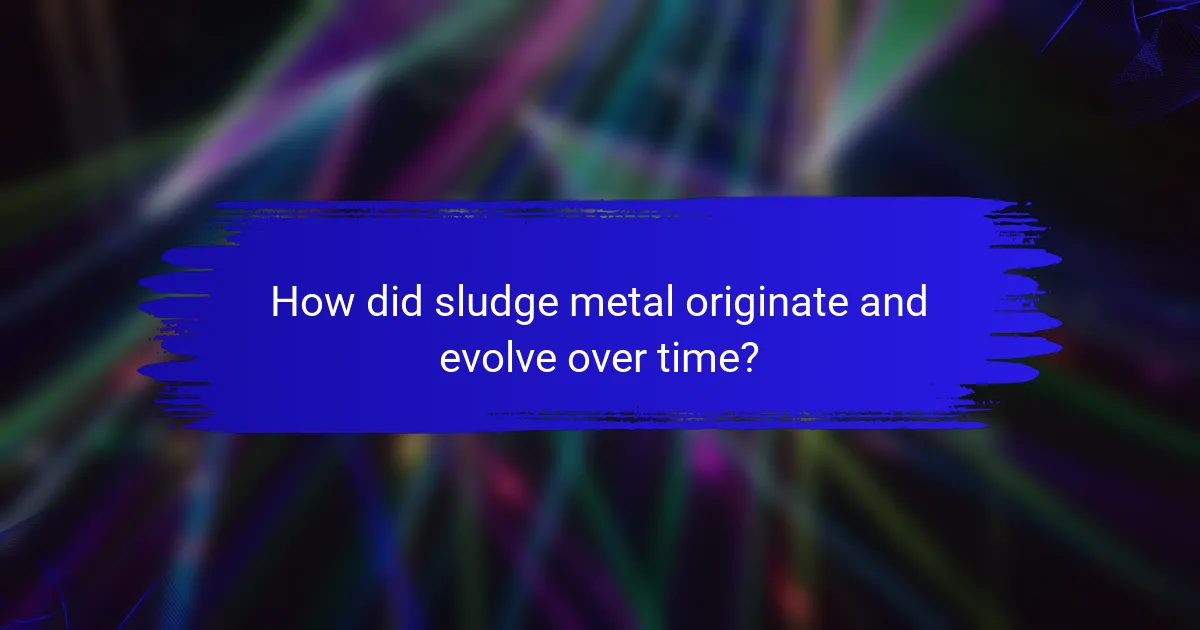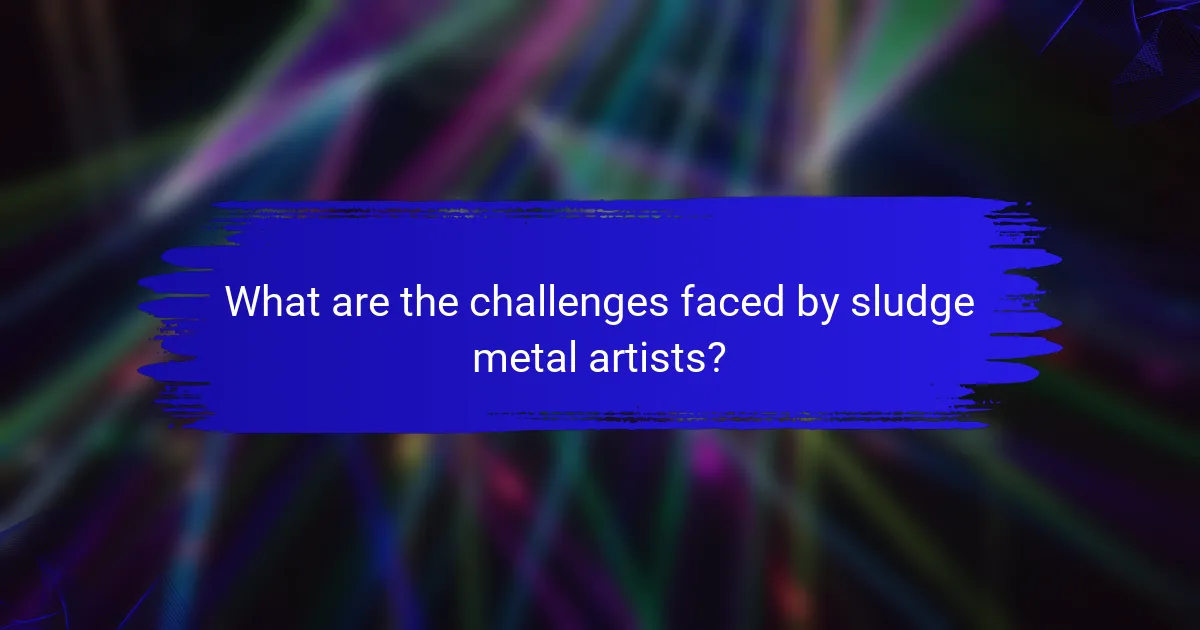Sludge metal captivates with its heavy sound and emotional intensity. This article explores its origins in the late 1980s, defining characteristics like slow tempos and distorted riffs, and highlights leading acts such as Eyehategod and Crowbar. It also addresses the challenges artists face within the genre and offers insights for emerging bands looking to make their mark.

What are the defining characteristics of sludge metal?
Sludge metal is characterized by its heavy, slow tempos, distorted guitar riffs, and a blend of doom and hardcore punk influences. Originating in the early 1990s, it often features harsh, growled vocals and a gritty production style. Notable acts include Eyehategod and Crowbar, known for their unique sound and cultural impact. The genre’s defining attributes include a focus on atmosphere, emotional intensity, and themes of despair.
How does sludge metal differ from other metal genres?
Sludge metal differs from other metal genres through its fusion of doom metal’s heaviness and hardcore punk’s aggression. It features slower tempos, thick guitar riffs, and a raw vocal style. Sludge metal often incorporates elements of blues and stoner rock, creating a unique sound. Leading acts like Eyehategod and Crowbar exemplify this genre’s distinct characteristics.
Which instruments are commonly used in sludge metal?
Sludge metal commonly employs instruments such as electric guitars, bass guitars, drums, and keyboards. Electric guitars often feature heavy distortion, creating a thick, sludgy sound. Bass guitars provide deep, resonant tones that enhance the overall heaviness. Drums contribute to the genre’s slow, crushing rhythms. Keyboards may add atmospheric elements, enriching the sonic texture.
What lyrical themes are prevalent in sludge metal?
Lyrical themes in sludge metal often focus on despair, existentialism, and social issues. These themes reflect the genre’s heavy, oppressive sound and its roots in punk and doom metal. Common topics include personal struggles, environmental decay, and critiques of modern society. Bands like Eyehategod and Crowbar exemplify these themes through their raw, emotive lyrics.

How did sludge metal originate and evolve over time?
Sludge metal originated in the late 1980s, blending elements of doom metal and hardcore punk. The genre is characterized by heavy, distorted guitar riffs, slow tempos, and a raw, gritty vocal style. Pioneering acts like Eyehategod and Crowbar played crucial roles in its development. Over time, sludge metal evolved by incorporating influences from other genres, such as stoner rock and post-metal, leading to a diverse range of sounds and styles within the genre. Today, sludge metal continues to thrive, with bands exploring new sonic territories while maintaining its core characteristics.
Which bands were instrumental in the early development of sludge metal?
Bands like Melvins, Eyehategod, and Crowbar were instrumental in the early development of sludge metal. Melvins combined heavy metal with punk influences, establishing a slow, heavy sound. Eyehategod brought a raw, gritty style that emphasized themes of despair. Crowbar contributed to the genre with their signature down-tuned guitars and emotional intensity. These acts laid the groundwork for sludge metal’s distinctive blend of doom and hardcore punk elements.
What cultural influences shaped the sludge metal scene?
Cultural influences that shaped the sludge metal scene include Southern rock, punk, and early heavy metal. These genres contributed to sludge metal’s heavy, slow sound and lyrical themes. Bands like Black Sabbath and Melvins are pivotal, blending elements of doom and noise rock. The scene emerged in the late 1980s, particularly in the American South, reflecting a gritty, working-class ethos.

Which are the most influential sludge metal bands today?
The most influential sludge metal bands today include Eyehategod, Crowbar, and Melvins. These bands shape the genre with their heavy sound and distinct characteristics.
Eyehategod is known for its blend of punk and doom elements, creating a raw, aggressive style. Crowbar emphasizes slow, heavy riffs and powerful lyrics, contributing to their lasting impact. Melvins, often credited with pioneering the genre, combine experimental elements with sludge, influencing countless acts.
Other notable bands include Baroness and Mastodon, which incorporate sludge elements while exploring progressive and alternative sounds. These bands keep the genre evolving, attracting new listeners while honoring its roots.
What makes these bands stand out in the genre?
Sludge metal bands stand out due to their heavy, distorted sound, blending doom metal and hardcore punk. They often feature slow tempos, sludgy riffs, and harsh vocals, creating a unique atmosphere. Bands like Eyehategod and Crowbar exemplify these characteristics, influencing the genre’s evolution. Their lyrical themes often explore despair and existentialism, further distinguishing them in the metal landscape.
How do regional scenes affect sludge metal bands?
Regional scenes significantly influence sludge metal bands by shaping their sound, themes, and cultural identity. Local music scenes provide unique attributes, such as distinct lyrical content reflecting regional struggles or environmental issues. For example, bands from New Orleans often incorporate elements of blues and jazz, while those from the Pacific Northwest may emphasize themes of nature and isolation. These regional characteristics contribute to the overall diversity within the sludge metal genre, allowing for a rich tapestry of influences that resonate with local audiences. As a result, sludge metal bands often reflect the ethos and challenges of their geographical origins, making their music a powerful expression of place.

What are the unique attributes of sludge metal?
Sludge metal is characterized by its heavy, slow tempos and a fusion of doom metal and hardcore punk elements. Unique attributes include a focus on atmospheric soundscapes, often featuring down-tuned guitars and harsh vocals. The genre frequently explores themes of despair, environmental decay, and personal struggle. Prominent acts like Eyehategod and Crowbar exemplify these traits, contributing to sludge metal’s distinct identity.
How does production quality impact the sludge metal sound?
Production quality significantly impacts the sludge metal sound by shaping its heaviness and texture. High production quality can enhance clarity, allowing intricate guitar riffs and bass lines to be heard distinctly. Conversely, lower production quality often results in a raw, abrasive sound that emphasizes heaviness and distortion, which is characteristic of the genre. This dichotomy influences how the music is perceived, with polished productions appealing to a broader audience while lo-fi recordings resonate with purists. Overall, production quality is a pivotal attribute that defines the listening experience in sludge metal.
What role does live performance play in sludge metal culture?
Live performance is central to sludge metal culture, fostering community and emotional connection. It serves as a platform for bands to convey the genre’s heavy themes and raw sound. The immersive experience of live shows enhances audience engagement, creating a shared atmosphere that resonates with the music’s intensity. Unique attributes of sludge metal, such as its slow tempos and heavy distortion, are best appreciated in a live setting, where the physicality of the sound can be fully experienced. Leading acts often emphasize elaborate stage setups, contributing to the overall aesthetic and emotional impact of their performances.

What are the challenges faced by sludge metal artists?
Sludge metal artists face challenges related to genre acceptance, limited mainstream exposure, and the struggle to maintain originality. The genre’s heavy sound often alienates wider audiences. Additionally, artists frequently deal with financial constraints due to niche market dynamics. Balancing artistic integrity with commercial viability poses another significant hurdle.
How do sludge metal bands navigate the music industry?
Sludge metal bands navigate the music industry by embracing a DIY ethos and building strong community ties. They often self-produce albums, which allows for creative freedom and direct engagement with fans. Collaborations with underground labels help them reach niche audiences. Touring extensively is crucial, as live performances strengthen their fan base and generate revenue. Social media serves as a platform for promotion and interaction, enabling bands to cultivate a loyal following. Unique sound characteristics, such as heavy riffs and slow tempos, differentiate them in a crowded market, enhancing their appeal.
What are common misconceptions about sludge metal?
Many misconceptions about sludge metal stem from its heavy sound and themes. People often confuse it with doom metal, but sludge metal incorporates elements of punk and hardcore. Another misconception is that all sludge metal bands have a similar style, while in reality, they vary widely in instrumentation and vocal delivery. Additionally, some believe sludge metal lacks melody, but many bands integrate melodic elements into their compositions.

What are the best practices for new sludge metal bands?
New sludge metal bands should focus on cultivating a unique sound, experimenting with heavy riffs, and maintaining a strong stage presence. Collaborating with established acts can enhance visibility. Networking within the metal community is essential for building a fan base. Regularly releasing quality recordings and engaging with fans on social media will help sustain interest. Emphasizing authenticity and passion in their music can set them apart in a crowded genre.
How can emerging artists find their unique sound in sludge metal?
Emerging artists can find their unique sound in sludge metal by experimenting with heavy riffs, slow tempos, and layered textures. This genre’s origins stem from a blend of doom metal and hardcore punk, characterized by its gritty sound. Artists should analyze the unique attributes of leading acts like Eyehategod and Crowbar, focusing on their use of dissonance and emotional intensity. Collaborating with other musicians and incorporating diverse influences can also help shape a distinctive style.
What strategies can bands use to build a fanbase?
Bands can build a fanbase by engaging with their audience through social media, live performances, and collaborations.
Social media platforms allow bands to share their music, interact with fans, and create a community. Regular updates and behind-the-scenes content can enhance fan connection.
Live performances are crucial for building a local following. Engaging shows and networking with other local acts can attract new fans.
Collaborations with other artists can introduce bands to different audiences. This strategy often leads to increased exposure and fanbase growth.
Additionally, offering exclusive content, such as early releases or merchandise, can incentivize fans to support the band.